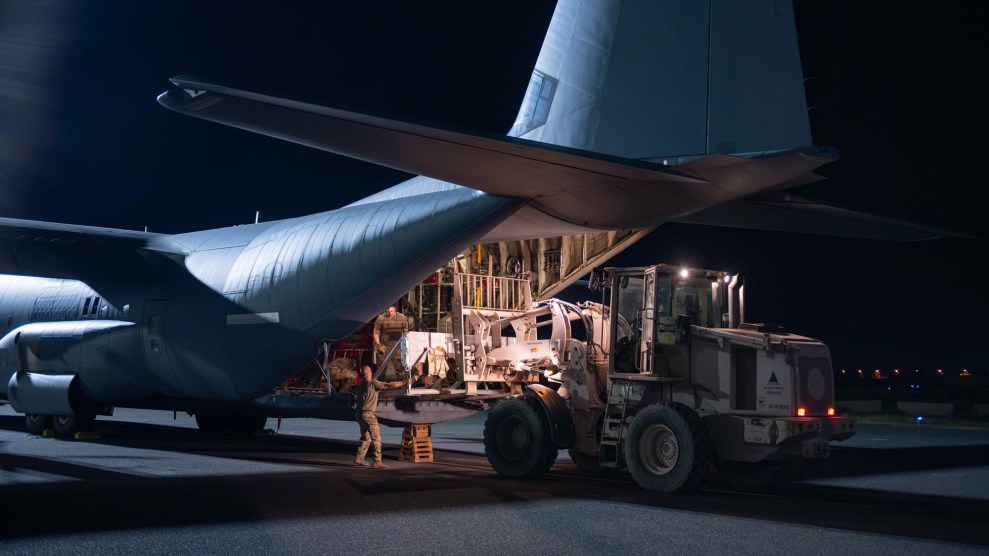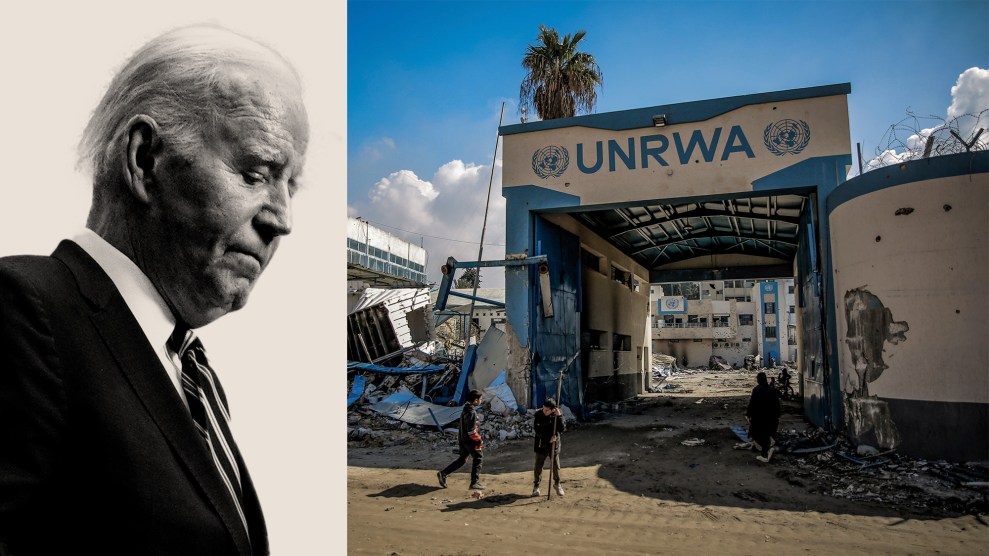
U.S. Army soldiers loads pallets of humanitarian aid in the cargo bay of a U.S. Air Force C-130J Super Hercules aircraft. The food aid will be airdropped to Palestinian refugees trapped by the Israeli war against Hamas.Sra Lauren Jacoby/Us Airforce/ZUMA
Over the weekend, the United States and Jordan airdropped 66 bundles of aid containing 38,000 meals into Gaza. Israel’s war on the densely populated strip following the October 7 attack by Hamas has killed over 30,000 and wrought a humanitarian disaster. Basic social systems have vanished and UN officials have been warning that almost a quarter of the population in Gaza, more than 500,000 people, are “one step away from famine.”
The US Central Command described the policy as “part of a sustained effort to get more aid” into the area. On Tuesday, the Pentagon announced a second airdrop with an additional 36,800 meals.
But as conditions in Gaza continue to deteriorate, humanitarian aid policy experts have criticized the policy, calling airdrops inadequate and “embarrassing” for the US government. Robert Ford, a fellow at the Middle East Institute and former ambassador to Syria and Algeria, told the New York Times the airdrops are a “humiliation” for the United States, noting the “absurdity” of using the US military to deliver aid into a territory controlled by an ally. Scott Paul, humanitarian policy lead at Oxfam America, said the airdrops only served to “relieve the guilty consciences” of government officials.
As my colleague Noah Lanard reported, the UN aid agency established to help Palestinian refugees, known as UNRWA, was hamstrung after Israeli intelligence alleged in January that a handful of UNRWA employees had participated in Hamas’ October 7 attack. Soon after, the Biden administration suspended funding. This created a chain reaction of countries cutting off money for UNRWA that has pushed the aid group most essential to helping Gaza to a “breaking point,” said Philippe Lazzarini, the head of the agency. (The independent UN investigation of UNRWA remains ongoing and the United States has not independently confirmed Israel’s claims of October 7 participation.) This week, the European Union restored some of its funding to UNRWA.
The inability to get aid into Gaza has been disastrous. Last Thursday, 118 Palestinians were killed and hundreds more got injured after Israeli forces opened fire on a starving crowd desperately trying to access food from a convoy of aid trucks. The incident has since been named the “Flour Massacre.”
“Air drops are primarily for the Biden administration’s benefit—to paper over a massive policy failure,” Dave Harden, managing director and founder of Georgetown Strategy Group, former USAID mission director to West Bank and Gaza, and senior adviser to Barack Obama’s Special Envoy for Middle East Peace, explained on X. They “are inefficient, expensive, dangerous, and only helpful when there are no other delivery options.”
Mother Jones spoke with Harden about the Biden administration’s decision to resort to airdrops:
Can you paint a picture of what the situation is right now for humanitarian aid groups trying to deliver supplies?
Gaza is facing an enormous humanitarian crisis and it’s on the brink of famine. Nearly the entire 2.2 million people in Gaza have a severe crisis of food security and that’s been determined by the IPC, a UN entity that evaluates food security. In Gaza, there are farms, greenhouses, poultry facilities, grocery stores, and bakeries. (All of that is essentially private sector trade.) In addition, as historically has been the case, the UN and NGOs send in assistance. All of that is broken, all that is shut down.
The deconfliction mechanisms between the Israelis and the NGOs is weak: No one wants to travel into Gaza if you think you’re going to get bombed; Hamas has diverted and manipulated the use of aid. There has been violence and chaos, people who are desperately starving. And there are armed gangs now that hijack the aid. The Hamas police—who provided some level of law and order in Gaza—have been dismantled. People are desperate. If people weren’t desperate, then they wouldn’t fight over a food basket. It’s not simply handouts that matter, the entire system needs to be restored.
More than 100 Palestinians were killed and hundreds more injured last week as people rushed to get food from aid trucks, with witnesses reportedly saying Israel forces shot at the crowd. What are the risks and advantages associated with high-altitude airdrops?
What happened last Thursday was foreseeable and predictable. Setting aside the actual details of who fired against whom and what the cause was, the violence in the chaos is completely foreseeable. That will happen over and over and over again if there’s simply not enough food. When there’s a massive deficit like this, if it’s not chaos, then it will be hijacked by strong networks, whether that’s Hamas or armed gangs. The Israelis brought it in and none of it was coordinated into a distribution system where the neediest were first in line.
The high-altitude airdrops don’t solve this problem—at all.
We do high-altitude airdrops in areas where we have adversaries that are blocking access. In this case, the Israelis control all the access. It’s a very unusual situation that we’re providing airdrops into an environment that Israel controls.
You and other experts have described the first round of airdrops as woefully insufficient. Are these first rounds of airdrops—and subsequent ones—likely to have any meaningful impact on the humanitarian crises in Gaza?
Airdropping 38,000 ready-to-eat meals from a 30,000-foot US Air Force C-130 is inefficient and expensive. It increases the odds that it’s not the most vulnerable people who get the food but the strongest, best-connected people. And it’s a minuscule amount. They need 6.6 million meals a day and we sent 38,000 meals on Saturday and 36,000 on Tuesday. It’s not consequential.
Further, it wasn’t coordinated with on-the-ground humanitarian actors so that those in most need would get food. In this instance, it was those who were able to run fast and carry it who got the food.
We shouldn’t be focused on airdrops. We should be focused on the crossings. That’s where you get the volume. That’s where you get the grain conveyors that are going to move 40 tons of wheat flour.
Let’s say each meal that is ready to eat weighs one pound. We dropped 38,000 meals. That’s 38,000 pounds. One truck carries somewhere between 40,000 pounds and 80,000 pounds. That airdrop was a truck—and you need 500, 700…1,000 trucks a day!
Airdrops are just not the answer. Airdrops are just a shimmering stunt.
A very small NGO, Anera, does 150,000 meals a day. They do four times the amount of meals that the United States Air Force did, but every single day. The US Air Force had two drops in four days. A small NGO is effectively doing much better.
Where would the US government efforts be better spent and what needs to happen moving forward?
It would be better to spend the time and effort and energy to open up all the crossings. Currently, the open ones are Kerem Shalom, on the Israel side, and Rafah, on the Egyptian side. Before October 7, Kerem Shalom was the only crossing that was used for goods into Gaza and it was completely controlled by the Israelis. Somewhere between 500 to 700 trucks every day went in. That wasn’t all food, but also supplies, bulk goods, and materials. The current situation is in such a deficit that the number of trucks that go in needs to be well above what the pre-October standard was.
The Israelis have the capacity to inspect these trucks that are going in and they have a right to inspect to make sure it doesn’t have contraband or weapons or bombs. You want to flood in as much food as possible through multiple decentralized crossing points so that no one bag of food basket is valuable. It lowers the value and lower value means lower violence, chaos, and risk.
All the other things that people talk about—airdrops, ports that don’t exist—that doesn’t get to the core problem.
What do the airdrops say about the Biden administration’s approach to Israel?
It demonstrates to me a lack of strength by the administration vis-a-vis the Netanyahu administration. The Biden administration is supplying Israelis with the military equipment necessary to conduct this war. That alone should mean that Israel should be willing to open up the crossings to supply the food—the food that we’re probably paying for through the World Food Program.
Under international humanitarian law, the occupying authority has a duty of care to the civilian population. The whole world doesn’t have to do anything—Israelis have to do something as the occupying authority in Gaza. Their responsibility is to avert a humanitarian crisis.
This conversation has been edited for length and clarity.
















